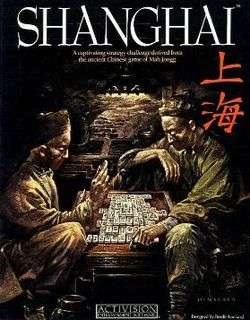Shanghai (video game)
| Shanghai | |
|---|---|
 | |
| Publisher(s) | Activision |
| Platform(s) | Amiga, Amstrad CPC, Apple II, Apple IIGS, Atari 8-bit, Atari Lynx, Atari ST, C64, FM Towns, Game Boy, Macintosh, MS-DOS, MSX, NEC PC-8801, NEC PC-9801, NES, Master System, Sharp X1, X68000, TRS-80 CoCo, TurboGrafx-16 |
| Release | 1986 |
Shanghai is a computerized version of mahjong solitaire published by Activision in 1986 for the Amiga, Atari ST, Atari 8-bit family, Commodore 64, IBM PC, Macintosh, Apple IIGS and Master System.
Gameplay
After winning a game, the tiles reveal the three-dimensional blinking eye of a dragon behind the game screen.[1] The Macintosh and Sega Master System version shows an animated dragon spitting fire.
Reception
Shanghai was successful, selling more than 500,000 copies by 1991.[2] Computer Gaming World in December 1986 published varying opinions. Gregg Williams stated, "I couldn't believe [Activision] had wasted their resources on putting it out",[3] while Charles Ardai called it "probably the best game of the year".[4] Info gave the Amiga version four-plus stars out of five, stating "This program ought to be illegal. It is impossible to play 'just one game'". Describing gameplay as "swift and deceptively simple", the magazine warned "Plan on spending a LOT of time with this one".[5] It gave the Commodore 64 version three-plus stars out of five, describing Shanghai as "fanatically addictive". While criticizing the user interface and graphics, the magazine concluded that "you'll find it hard to quit".[6] Compute! reviewed the game favorably, reporting that "our Shanghai mania is of such proportions that I am beginning to fear for our health".[7] In 1988, Dragon gave the game 5 out of 5 stars.[1]
Atari Lynx
Dragon Magazine also gave the Atari Lynx version 5 stars in their May 1992 issue.[8] Robert Jung of IGN gave the game a score of 10 out of 10 in his review.[9] CVG Magazine reviewed the game in their March 1991 issue giving a score of 84 out of 100.[10]
Development and legacy
Shanghai was programmed by Brodie Lockard,[1] and produced by Brad Fregger.
The sequel, Shanghai II: Dragon's Eye, was developed for PC,[11] Sega Genesis, and Super NES. The Genesis version was re-released on the Wii Virtual Console in the PAL regions on November 27, 2009 and in North America on January 11, 2010, which was later delisted at the end of 2013.
References
- 1 2 3 Lesser, Hartley; Lesser, Patricia; Lesser, Kirk (October 1988). "The Role of Computers". Dragon (138): 70–75.
- ↑ Emrich, Alan (February 1991). "A Good Deal, Better / Activision's Shanghai II". Computer Gaming World. p. 10. Retrieved 17 November 2013.
- ↑ Williams, Gregg (December 1986). "Hacker II". Computer Gaming World. p. 18.
- ↑ Ardai, Charles (December 1986). "Year in Review". Computer Gaming World. p. 20.
- ↑ Dunnington, Benn; Brown, Mark R.; Malcolm, Tom (January–February 1987). "Amiga Gallery". Info. pp. 90–95.
- ↑ Dunnington, Benn; Brown, Mark R.; Malcolm, Tom (January–February 1987). "64/128 Gallery". Info. pp. 14–21.
- ↑ Bobo, Ervin (February 1987). "Shanghai". Compute!. p. 32. Retrieved 9 November 2013.
- ↑ Lesser, Hartley; Lesser, Patricia; Lesser, Kirk (May 1992). "The Role of Computers". Dragon (181): 57–62.
- ↑ Jung, Robert A. (6 July 1999). "An excellent version of Shanghai, preserving all of the charm of the original game -- and more". IGN. Retrieved 28 March 2018.
- ↑ "Bytesize Atari Lynx". No. 112. CVG Magazine. March 1991. p. 71. Retrieved 28 March 2018.
- ↑ "These Just In". Now Playing. Computer Gaming World. August 1994. pp. 152–156.
External links
- Shanghai at MobyGames
- Shanghai II: Dragon's Eye playable copy using dosbox emulator at the Internet Archive